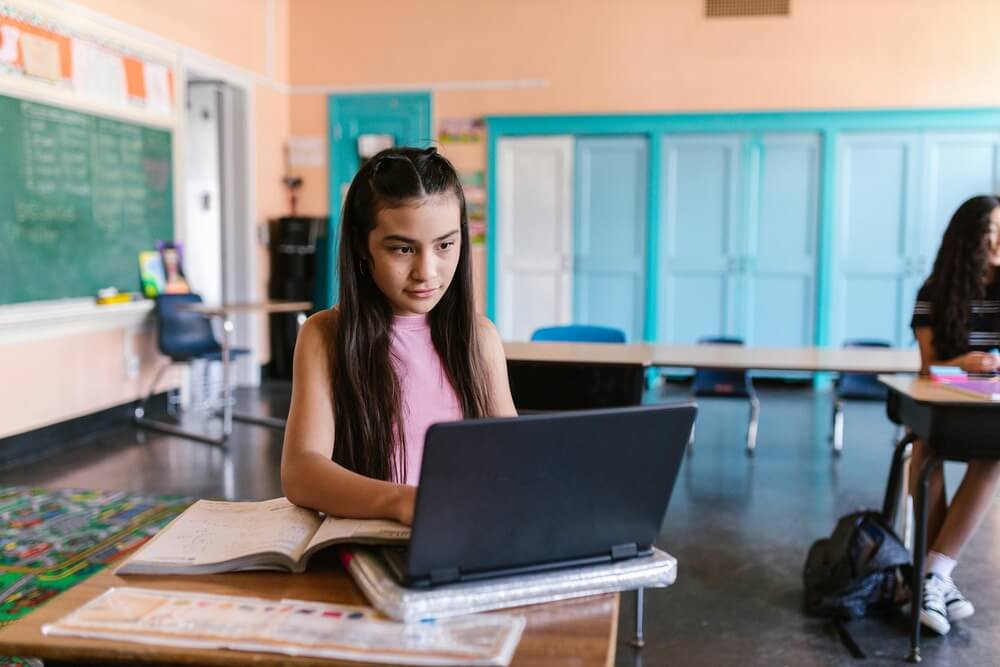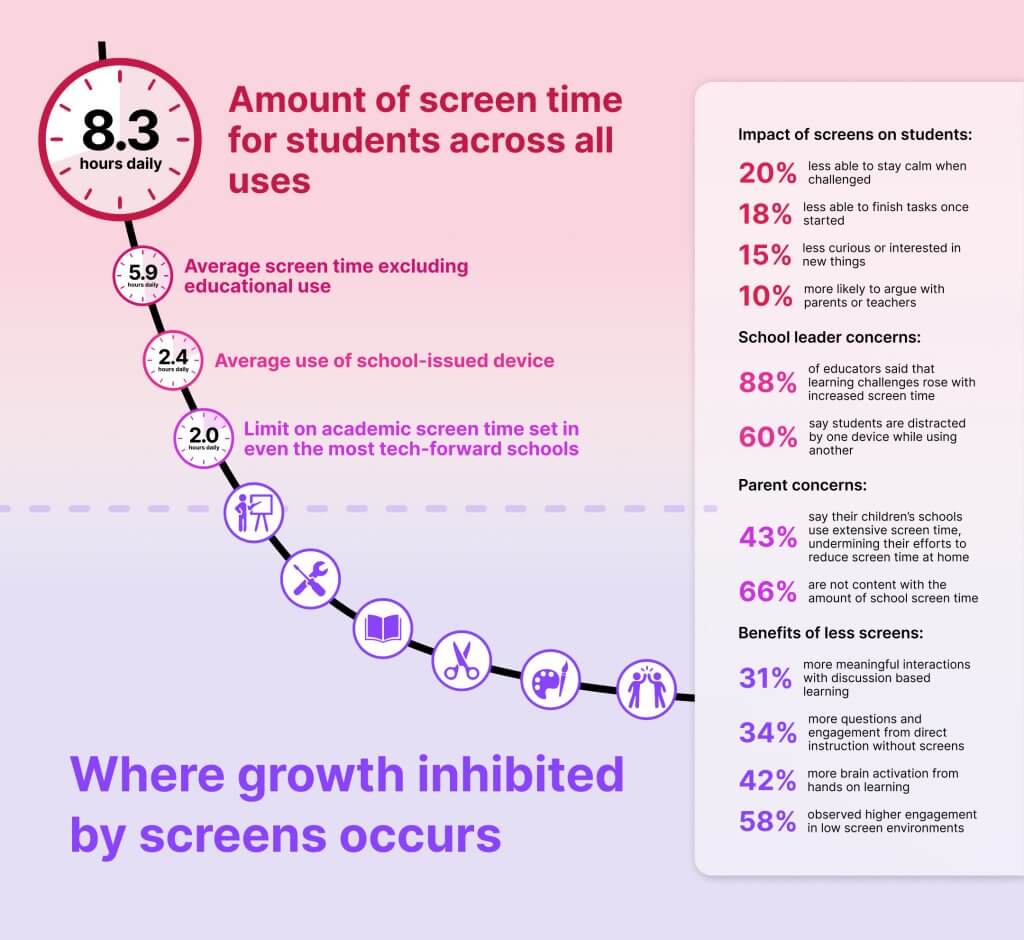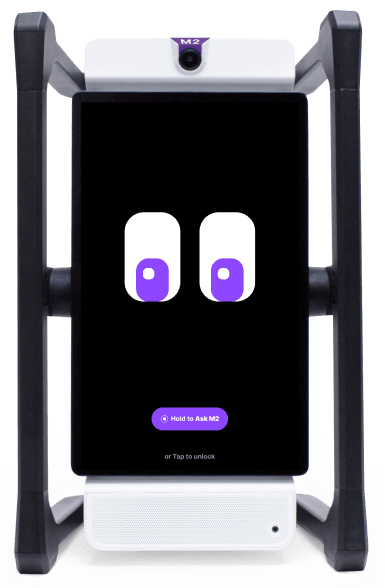
Screens are now a staple of everyday life. Outside school, daily routines feel like a series of transitions between screens of different sizes. Most parents depend on them to keep kids entertained and behaving. In school, one-to-one programs have become the norm, with screens used prolifically to personalize lessons and hold student attention.
Too often, classes become scrolling, clicking, submitting. Eyes glued to screens. Nobody talking. Even after the return to in-person learning, student screen time has stayed elevated compared to pre-pandemic levels.
Beyond the obvious isolation this creates, a hidden cost is emerging. People often say, “modern learners are different.” The reality is subtler: learners now rely on screens not just to learn, but to function. That dependence is reshaping how minds develop.
Research shows students distracted by others’ devices score 15 points lower in math, and simply having a laptop in the room lowers comprehension and memory, even if it’s closed.
Banning phones in schools is a step in the right direction. But the question remains: is it enough?
What does dependence look like?

Dependence isn’t simply about whether screens are used, it’s about the role they play in shaping the habits and behaviors of individual students and the classroom as a whole. The issue is not technology itself, but what gets displaced when screens become the default mode of engagement. A few key patterns of screen dependence stand out:
- Escape and distraction — Students retreat into screens to avoid reality, constantly checking devices instead of listening or engaging. Over time this erodes self-regulation, making it harder to cope with the everyday demands of school or home.
- Automatic use instead of intentional use — Lessons, assignments, and even casual conversations default to screens, not because they’re the best option, but because they’re always available. This convenience narrows the range of experiences students have for learning.
- Shortcuts over struggle — Students lean on devices for quick answers, bypassing the productive friction where deeper thinking and lasting learning happen. The result is knowledge without resilience.
- Suppressing opportunities for growth — When screens dominate, face-to-face interaction, reflection, and collaborative problem-solving are pushed aside. These are the very experiences that develop empathy, creativity, and higher-order thinking.
What might be reshaping minds?
There is ongoing debate and research about the effects of screens, and a clear consensus has yet to emerge. But one fundamental principle of learning is well established: it requires reflection. Growth comes from the ability to step back from experience, view information from new perspectives, and integrate those shifts. Psychologists call this process cognitive differentiation or decentering of thinking. And it most often emerges in the context of human interaction.
When learning is dominated by screens — especially since so much of students’ lives outside school already is — those conditions become far less likely. Screens are designed to hold attention and keep users immersed in the experience. But immersion is the opposite of reflection. Instead of encouraging students to decenter, screen use often reinforces self-centered thinking, leaving ideas unexamined and growth stalled.
This explains why today’s learners feel different: they are not developing the same reflective capacities that previous generations built more naturally through interacting with people and the natural world. As a result, many students remain “stuck” in their current ways of thinking. This brings new needs, and new pressures, into classrooms.
The evidence of the hidden costs are now piling up. Seventy-two percent of educators say students are tired of devices in school, and parents too are voicing concern about adding to that load. In another survey, 88% of educators said more screen time made learning challenges worse, and 80% said behavior had declined — with a third saying it’s gotten much worse.
Tackling screen dependence is becoming the educational challenge of our time, especially now with the arrival of AI.
So what’s the answer?
Some are making the case to remove screens entirely. In a recent People interview, social psychologist and author of The Anxious Generation, Jonathan Haidt, didn’t hold back:
“The one-to-one devices was the colossal mistake… The biggest driver of the decline of education is the phones in the pockets and the Chromebooks on the desks.”
But that goes too far. Screens bring too many benefits to ignore.
The real challenge is that even great teachers have limits. They can only plan so much, guide so many students at once, and give so much attention to the growing list of individual needs. On top of that, modern learners are different, because their experiences outside of school are so different, and that’s why so many schools turned to technology in the first place.
Still, problems remain whenever screen-based learning takes hold. Now with AI integrated into everything, “Active” lessons can easily slide into low-effort tech use. Students can short-circuit learning by reaching for quick answers instead of working through deeper thinking. So yes, limiting screen time is essential—even for the most tech-forward schools. But limits alone are not enough.
Students need off-screen learning experiences to build real mastery, especially the mastery they are going to need in an AI future. The research is clear:
- Print and physical materials often outperform screens for comprehension and retention.
- Students are more likely to succeed at higher-level problem-solving when learning from non-digital materials.
- For “deeper reading,” paper clearly wins, with screens linked to more shallow reading.
With these concerns in mind, a better answer includes:
- Limiting screen time during the school day.
- Great direct instruction with devices off and put away.
- Adding rich off-screen and social learning activities where students face each other, not a screen.
- Creating frequent opportunities for students to reflect and differentiate their thinking.
To make this possible consistently, teachers need help. The real solution is technology that augments teaching and learning without fueling dependence.
Differentiation that differentiates
M2 has a screen, but it isn’t built for constant interaction. It turns itself off when not needed, staying on only to signal that it’s there to help without becoming the focus.
Instead of adding to screen dependence, M2 extends a teacher’s reach and creates more space for human connection and deeper thinking. It listens, observes, and understands classroom context, then responds strategically when called upon — during direct instruction, small-group activities, or hands-on projects.
By putting teachers and students back at the center, M2 keeps learning human and ensures screens set the stage for growth instead of limiting it.
See M2 in action
Book a meeting and explore how this intelligent co-teacher helps schools move past dependence and unlock real growth.

Ready to discover how M2 can minimize dependence on screens in your classrooms?
Click the button below to book a meeting with our team.